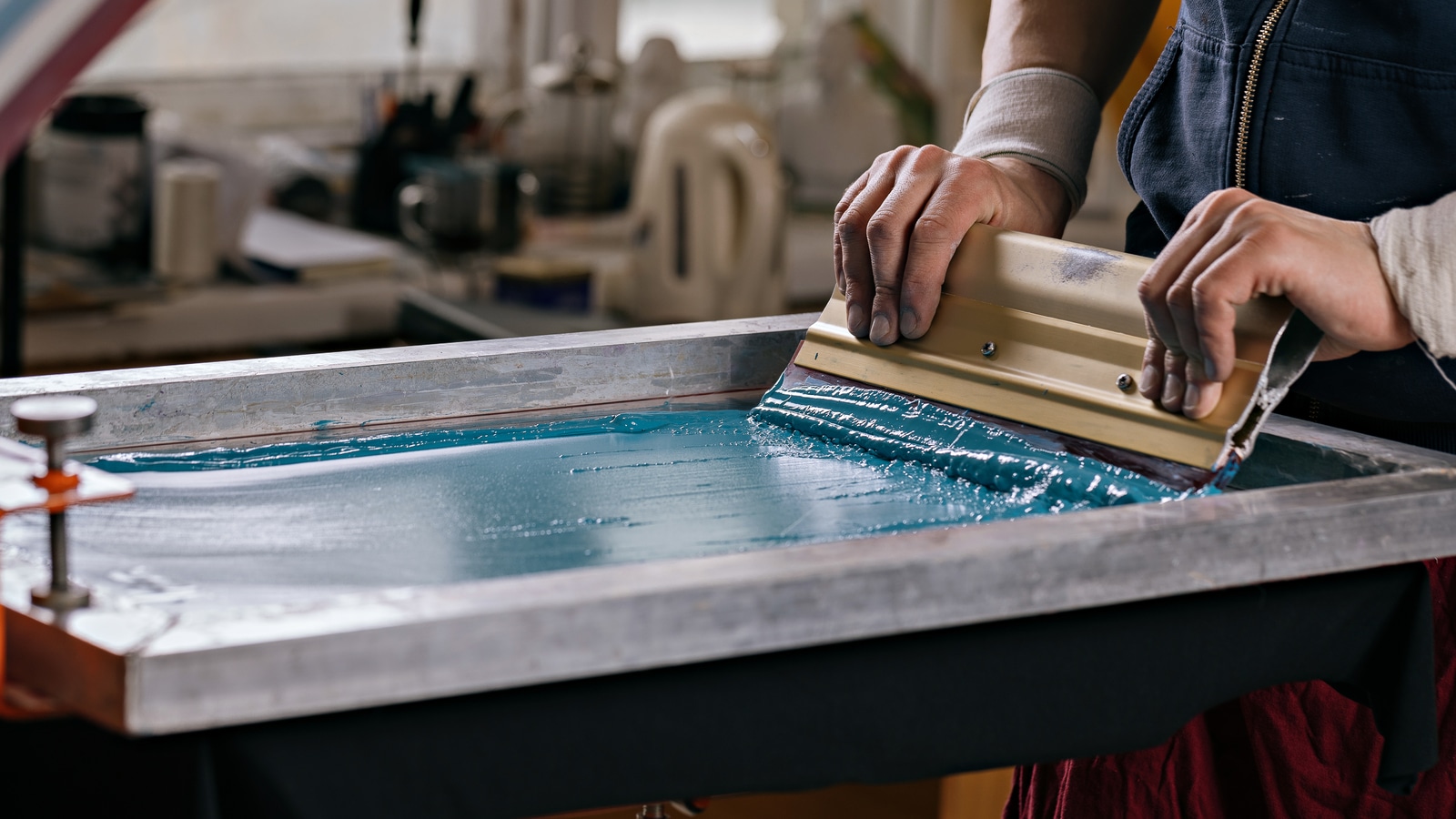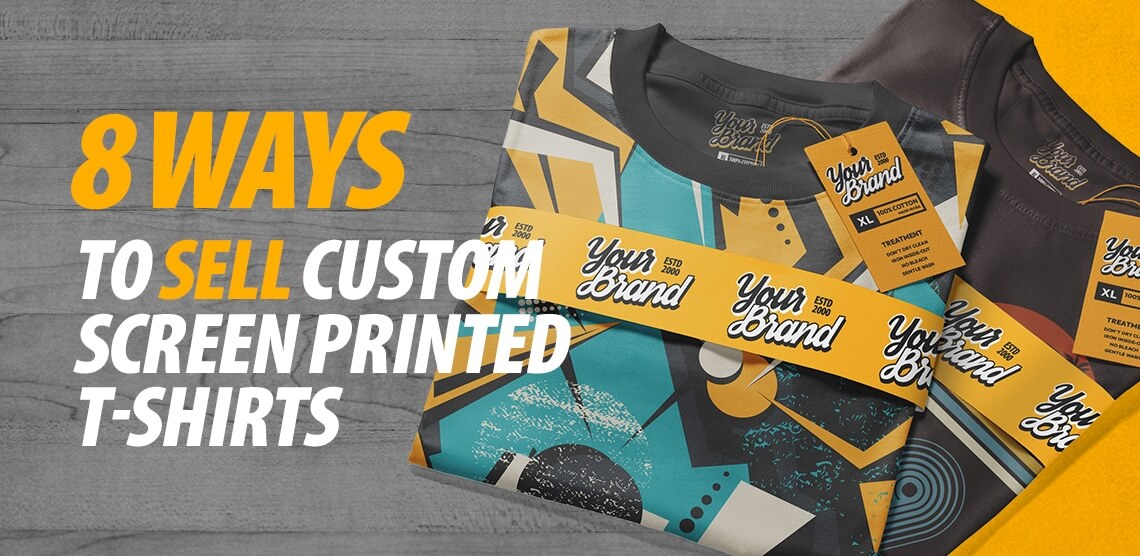Screen Printing Uncovered: Every Little Thing You Required to Learn About Tee Shirt and Garment Printing Techniques
If you've ever before asked yourself just how those vivid layouts wind up on your favored tees, you remain in the appropriate area. Display printing is a fascinating method that combines art with technique, using limitless opportunities for creative thinking. Understanding the basics, from tools to ink choices, can significantly influence your results. Prepared to discover the vital aspects that make display publishing an art kind? Allow's uncover the information that can elevate your jobs.
The Fundamentals of Screen Printing: Exactly How It Works
When you plunge right into screen printing, you'll uncover it's both a scientific research and an art. At its core, display printing entails developing a stencil, or screen, that enables ink to pass via only in particular locations (screen printing kit). You start by picking your layout and preparing your screen with a light-sensitive solution. Once you subject this solution to light, it sets, leaving your design as an adverse area.
Following, you'll blend your inks and prepare your printing surface. Setting the display over the material, after that use a squeegee to press ink with the screen onto the garment. This procedure calls for accuracy, as you want clear, dynamic prints. After printing, you'll cure the ink with warm, guaranteeing it sticks to the material and lasts through laundries. Each step is necessary, and mastering them will boost your screen printing abilities, changing easy garments into one-of-a-kind, expressive items.
Kinds Of Display Printing Techniques
When you realize the essentials of screen printing, it's time to explore the various methods that can raise your designs. One popular approach is conventional screen printing, where ink is pushed via a stenciled display. This technique is great for vibrant, vibrant shades. There's water-based ink printing, which supplies a softer feeling and is environment-friendly, yet it calls for a various method to treating.
Another option is plastisol printing, understood for its durability and vivid shades, making it a preferred for many brand names. Experiment with halftone printing to create slope effects and elaborate layouts.
Crucial Devices for Screen Printing
To achieve stunning outcomes in screen printing, having the ideal devices is essential. You'll need a tough screen printing framework, which holds the mesh that transfers your layout onto the garment. Next, spend in high-quality squeegees; these are necessary for applying ink evenly throughout the screen.
Selecting the Right Inks and Materials
When choosing inks and materials for display printing, you need to take right into account the kind of ink that works best for your task. Consider material compatibility to guarantee your designs look fantastic and last long. Also, discover eco-friendly ink options to make your printing procedure much more sustainable.
Sorts Of Display Inks
Choosing the best screen ink is vital for accomplishing dynamic, resilient prints that satisfy your job's requirements. There are several kinds of display inks to check out. Specialized inks, such as glow-in-the-dark or metal, can add special results to your designs.

Fabric Compatibility Factors To Consider
Understanding fabric compatibility is vital for attaining high-quality display prints, particularly because various products respond distinctively to numerous inks. Constantly examine your inks on example textile to ensure they stick effectively and maintain shade stability. In addition, maintain in mind that material weight and structure can affect the last outcome, so choosing the ideal ink and material combo is essential for your job's success.
Eco-Friendly Ink Options
Eco-friendly inks are ending up being a prominent option for display printers that wish to lessen their ecological impact while maintaining high quality. When selecting inks, consider water-based inks, which are less damaging and much easier to tidy up compared to standard solvents. These inks bond well with materials, delivering dynamic outcomes without toxic chemicals. You might additionally check out eco-solvent inks that make use of fewer volatile organic compounds (VOCs), making them a much safer alternative for both your wellness and the world.
Furthermore, search for inks made from renewable sources, such as soy or vegetable-based choices. By selecting the appropriate inks and products, you'll not just develop magnificent layouts but also add to an extra sustainable printing procedure. Make the switch, and your prints will certainly show your commitment to the atmosphere!
Preparing Your Design for Display Printing

Submit Layout Needs
To ensure your style looks sharp and lively on material, you'll require to pay very close attention to file layout requirements for display printing. Beginning with vector files like AI or EPS, as they can be scaled without losing high quality. If you use raster photos, go with high-resolution files, such as TIFF or PNG, preferably at 300 DPI. Prevent making use of JPEGs, as they can lose clarity when resized. Additionally, ensure your style has a clear history to avoid undesirable white edges on your prints. Keep shade settings in mind; CMYK is common for display printing, so convert your RGB creates appropriately - screen printing kit. By adhering to these guidelines, you'll establish your art work up for an effective print.
Shade Splitting Up Strategies
Shade splitting up is an important action in preparing your design for display printing, and mastering it can considerably improve your print high quality. You'll require to break your design into private shades, as each shade calls for a separate screen throughout printing. Start by identifying all the shades in your design and produce layers for each one. You can use software application like Adobe Photoshop or Illustrator to isolate and different shades successfully. Be specific to save each layer as a different file, typically in a layout like TIFF or PSD. This precision not just assures accurate shade depiction yet also streamlines the printing procedure. By taking notice of color separation, you'll attain vivid and specialist outcomes in your screen-printed garments.
Resolution and Size
Accomplishing the best outcomes in display printing starts with assuring your design has the ideal resolution and size. Preferably, your art work ought to this contact form go to least 300 DPI (dots per inch) for sharp, clear prints. If you utilize reduced resolution, your end product might look amateur and pixelated.
When it concerns size, consider the measurements of your print location. Design your art work to match the final print size, preferably developing it in the real dimensions you'll be publishing. This method, you'll prevent any kind of unanticipated scaling issues.
Always examine your layout in both vector and raster styles. Vector graphics can be scaled without losing quality, making them ideal for display printing. Preparing properly will guarantee your design looks remarkable on every garment!
Step-by-Step Screen Printing Process
Display printing is a dynamic procedure that allows you to produce lively styles on different surface areas. To obtain begun, you'll need a screen, solution, and your selected ink.
Pour ink onto the display and utilize a squeegee to press the ink via the stencil onto the fabric. Raise the screen thoroughly and allow the print completely dry. You've effectively screen published your style.
Tips for Effective Display Printing Projects
While you're diving right into your display printing projects, bear in mind that preparation is vital to success. Beginning by collecting imp source all your materials-- inks, screens, garments, and mops. A tidy workspace aids prevent unwanted mistakes, so neat up prior to you start.
Following, validate your artwork is high-resolution and effectively sized for your garment. Examine your screen for proper exposure and clean it extensively to prevent smudges. When blending your inks, adhere to the producer's standards to attain the best consistency.
Throughout printing, apply even stress with your squeegee for regular results. Don't rush; take your time to verify each print satisfies your standards. After printing, let your garments completely dry entirely before taking care of or packaging them.
Lastly, always keep a sample of your job for future recommendation. In this manner, you can analyze your progress and enhance your techniques with time. Satisfied printing!

Regularly Asked Inquiries
For how long Does It Take to Set up a Screen Printing Task?
Establishing a display printing task normally takes around thirty minutes to an hour. You'll prepare the screens, mix inks, and readjust the press. The time differs based on intricacy and experience, so stay organized!
Can I Print on Different Material Keys In Utilizing the Exact Same Technique?
Yes, you can print on different material kinds using the same strategy, yet you'll need to readjust your inks and settings. Some materials absorb ink in a different way, so experimenting guarantees the most effective results for every material.
What Are Common Mistakes to Prevent in Display Printing?
When display printing, avoid usual errors like utilizing the wrong ink, ignoring proper direct exposure times, or skipping pre-press checks. Constantly check your configuration and preserve tidy screens to ensure high quality results each see page time.
How Can I Appropriately Tidy and Keep My Display Printing Devices?
To properly tidy and preserve your display printing devices, you should regularly wash displays with ideal solvents, inspect squeegees for wear, and ensure all tools are kept dry and dust-free. Consistency enhances and protects against costly repair work performance.
Is Display Printing Eco Friendly Contrasted to Various Other Methods?
Display printing can be more environmentally friendly than various other methods, particularly if you utilize eco-conscious materials and water-based inks. By selecting sustainable materials and techniques, you decrease waste and decrease your effect on the world.
Screen Printing Uncovered: Whatever You Need to Know About Tee Shirt and Garment Printing Methods
At its core, screen printing includes developing a stencil, or display, that enables ink to pass through just in certain areas. Placement the display over the fabric, then make use of a squeegee to press ink via the display onto the garment. One popular technique is standard screen printing, where ink is pressed with a stenciled display.When selecting inks and materials for display printing, you require to take into account the kind of ink that functions ideal for your task.